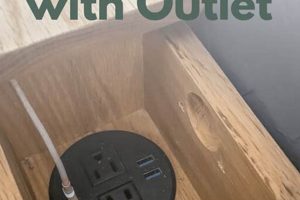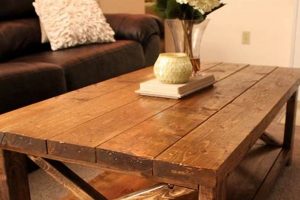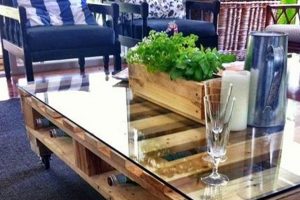The crafting of a low-lying furniture piece from repurposed wooden platforms represents a popular trend in sustainable home dcor. This approach centers on utilizing readily available and often discarded shipping structures to create a functional and aesthetically unique surface, typically used for placing beverages, books, or decorative items within a living room setting. An example would involve disassembling a standard four-way entry platform, sanding the individual planks, and reassembling them into a rectangular form, adding legs for elevation.
This method offers numerous advantages, including reduced material costs and environmental impact through resource reuse. Furthermore, it allows for considerable customization in terms of size, finish, and style, aligning the resulting piece with specific interior design schemes. Historically, the adaptation of industrial materials for domestic purposes reflects a broader movement toward resourceful living and individual expression within interior design.
The subsequent sections will detail the specific processes involved in constructing such a furniture piece, addressing essential considerations regarding material selection, preparation techniques, design options, and finishing touches. Safety precautions and recommended tools will also be outlined to ensure a successful and satisfying project outcome.
Essential Considerations for Pallet Coffee Table Construction
The following recommendations are designed to facilitate the creation of a durable and visually appealing furniture piece from reclaimed wooden platforms, ensuring a safe and structurally sound outcome.
Tip 1: Material Selection: Prioritize heat-treated platforms identified by the HT stamp. Avoid platforms marked with MB (methyl bromide), a toxic fumigant. Thoroughly inspect for damage, rot, or infestations before proceeding.
Tip 2: Platform Disassembly: Employ appropriate safety gear, including gloves and eye protection. Utilize a reciprocating saw or crowbar to carefully dismantle the structure, minimizing wood splintering and potential injury.
Tip 3: Wood Preparation: Thoroughly clean the wood using a stiff brush and appropriate cleaning solution. Sand all surfaces to a smooth finish, addressing splinters and imperfections. Consider using a power sander for efficiency.
Tip 4: Design Considerations: Plan dimensions according to room size and desired functionality. Explore various design options, such as incorporating storage shelves or drawers. Create a detailed sketch or blueprint before assembly.
Tip 5: Secure Fastening: Utilize screws rather than nails for superior structural integrity. Employ wood glue in conjunction with screws to create stronger joints. Ensure all fasteners are countersunk to prevent snagging.
Tip 6: Surface Finishing: Apply a sealant or varnish to protect the wood from moisture and wear. Consider staining the wood to achieve the desired color and aesthetic. Allow ample drying time between coats.
Tip 7: Leg Attachment: Select legs appropriate for the desired height and style. Securely attach legs using screws and metal brackets, ensuring even weight distribution and stability. Consider adjustable feet for uneven floors.
Adhering to these suggestions will result in a robust and aesthetically pleasing furniture piece, maximizing the utility and visual appeal of the chosen material.
The subsequent segment will address potential challenges encountered during construction and offer corresponding solutions, ensuring a seamless and efficient building process.
1. Sourcing Materials
The initial step in creating a functional furniture piece from repurposed shipping structures centers on the acquisition of suitable platforms. The choice of materials significantly impacts the final product’s structural integrity, aesthetic appeal, and overall safety. Careful consideration must be given to the platform’s origin, treatment, and physical condition.
- Platform Classification and Safety
Platforms are categorized based on their treatment and intended use. Heat-treated platforms, indicated by the “HT” stamp, are generally safe for indoor use. Conversely, platforms marked with “MB,” signifying methyl bromide fumigation, should be avoided due to potential health hazards. Opting for HT-stamped platforms mitigates the risk of exposure to harmful chemicals within the context of the intended furniture piece.
- Inspection for Damage and Contamination
A thorough inspection is crucial to identify any signs of structural damage, rot, or insect infestation. Cracked or broken boards compromise the furniture’s stability and load-bearing capacity. Evidence of rot indicates fungal decay, potentially weakening the wood. Insect infestations can spread to other wooden structures within the home. Rejection of compromised platforms ensures the longevity and structural soundness of the intended furniture piece.
- Dimensions and Quantity Considerations
The dimensions of available platforms influence the final furniture piece’s size and design. Determining the desired dimensions prior to sourcing materials allows for efficient selection and minimizes the need for extensive modification. Estimating the quantity of platforms required prevents project delays and ensures sufficient material for construction. Effective planning in this area enhances the efficiency of the building process.
- Ethical and Environmental Considerations
Sourcing materials from responsible sources aligns with sustainable practices and reduces environmental impact. Seeking platforms from local businesses or recycling centers supports community initiatives and minimizes transportation costs. Repurposing discarded platforms diverts waste from landfills and promotes resource conservation. Adhering to responsible sourcing practices contributes to a more sustainable approach to furniture construction.
The facets of material sourcing directly influence the feasibility and overall success of creating a repurposed furniture piece from shipping structures. Careful selection and inspection, combined with adherence to ethical and environmental considerations, contribute to a final product that is both functional and sustainable.
2. Platform Preparation
Platform preparation forms a crucial stage in the creation of a furniture piece from repurposed shipping platforms. The direct link between platform preparation and the final quality of the product, specifically a coffee table, is undeniable. Neglecting this stage invariably results in a structurally unsound, aesthetically unappealing, and potentially hazardous piece. The effects of improper preparation manifest in various ways, including splintering surfaces, uneven joints, and premature structural failure. A real-world example of this is the creation of a coffee table using platforms that have not been adequately cleaned. This might lead to embedded dirt and grime compromising the finish and potentially contaminating items placed on the table.
The importance of platform preparation extends beyond mere aesthetics. Thorough cleaning removes contaminants such as mold, mildew, and potentially harmful chemicals that may have been absorbed during the platform’s prior use. Sanding eliminates splinters and smooths the surface, preventing injury and creating a suitable base for finishing treatments like staining or sealing. Furthermore, proper platform disassembly, involving the careful removal of nails and staples, is essential for preventing damage to the wood and ensuring safe handling. These steps transform a raw, potentially hazardous material into a usable component.
In summary, platform preparation is not merely a preliminary step but an integral component of the overall building process. It ensures structural integrity, promotes aesthetic appeal, and safeguards against potential hazards. Understanding and prioritizing this stage is fundamental to successfully crafting a durable and functional piece of furniture from repurposed shipping platforms. Neglecting this preparation may result in substantial rework or, worse, a structurally compromised and potentially dangerous item.
3. Design Selection
The choice of design significantly dictates the final form and functionality of a furniture piece created from repurposed shipping platforms. The correlation between design selection and the viability of constructing a functional and aesthetically pleasing “diy pallet coffee table” is demonstrable. An ill-conceived design can lead to structural instability, inefficient material utilization, and a finished product that fails to meet intended needs. Conversely, a well-considered design optimizes material usage, enhances structural integrity, and results in a coffee table that seamlessly integrates into the designated environment. For example, a design that neglects to account for the weight distribution of items placed on the surface may result in bowing or collapse, rendering the table unusable. Careful pre-planning mitigates the occurrence of such issues.
Various design options exist, ranging from simple, minimalist structures to more complex designs incorporating storage compartments or integrated features. The selection process should consider the intended use, the available space, and the skill level of the individual undertaking the project. A novice builder may opt for a simpler design, focusing on basic construction techniques and readily available materials. An experienced builder may choose to implement more intricate designs, incorporating advanced joinery techniques and custom finishes. The choice of design also influences the overall aesthetic of the table, allowing for personalization and adaptation to various interior design styles. Furthermore, the selection process includes considerations related to the dimensions of the coffee table. The table’s height, width, and length are critical factors that affect its usability and compatibility with surrounding furniture.
In summary, design selection forms an indispensable element in the creation of a “diy pallet coffee table.” This selection process entails evaluating structural requirements, considering aesthetic preferences, and assessing the builder’s skill level. A comprehensive understanding of design principles and material properties enables the creation of a durable, functional, and visually appealing furniture piece. The challenges often lie in balancing aesthetic desires with structural limitations and practical considerations. The careful synthesis of these factors is paramount to achieving a successful outcome.
4. Structural Integrity
Structural integrity represents a critical factor in the design and construction of any “diy pallet coffee table”. The inherent nature of repurposed shipping platforms presents unique challenges regarding material consistency and load-bearing capacity. A failure to adequately address these challenges can result in a structurally unsound table, prone to collapse or premature failure under normal usage conditions. For instance, using platforms with significant rot or hidden internal damage may compromise the table’s ability to support the weight of items placed upon it. Securing connections between platform components requires careful selection of fasteners and appropriate joinery techniques to ensure stability over time. Consequently, structural integrity is not merely an aesthetic consideration but a fundamental safety requirement.
Achieving adequate structural integrity necessitates a thorough assessment of the platform’s condition and the implementation of appropriate reinforcement measures. This might involve adding internal supports, such as additional planks or metal bracing, to distribute weight more evenly. Furthermore, the method of leg attachment plays a crucial role in overall stability. Legs must be securely fastened to a robust section of the platform frame, utilizing appropriate hardware and techniques to prevent loosening or breakage under stress. The size and weight of the table itself must also be considered, as larger tables require more substantial structural support. Proper planning and execution are essential for creating a structurally sound and safe coffee table.
In conclusion, structural integrity is paramount in the creation of a functional and safe “diy pallet coffee table”. Careful material selection, reinforcement techniques, and robust leg attachment are essential components of achieving this goal. Neglecting these considerations can lead to a structurally deficient table, posing a potential hazard to users. Therefore, prioritizing structural integrity throughout the design and construction process is crucial for ensuring the longevity and safe operation of the finished product. The knowledge of a secure framework and foundation leads to the success outcome and satisfaction.
5. Surface Finishing
Surface finishing directly impacts the functionality, aesthetics, and longevity of a “diy pallet coffee table.” The application of appropriate surface treatments serves multiple critical purposes. Firstly, it creates a protective barrier against moisture, stains, and everyday wear and tear, preventing degradation of the underlying wood. Without proper finishing, the porous nature of wood allows liquids to penetrate, leading to swelling, warping, and the development of unsightly stains. Secondly, surface finishing enhances the visual appeal of the coffee table, allowing for customization through the application of stains, paints, or clear coats. The choice of finish dictates the final color, sheen, and texture of the piece, enabling integration into diverse interior design schemes. Thirdly, certain finishes, such as those containing UV inhibitors, protect the wood from fading and discoloration caused by prolonged exposure to sunlight. This protection is especially important for coffee tables positioned near windows. Therefore, surface finishing is an indispensable step in crafting a durable and aesthetically pleasing furniture item.
The selection of an appropriate surface finish depends on the desired aesthetic, the intended use of the coffee table, and the type of wood used in its construction. Oil-based finishes penetrate deeply into the wood, providing enhanced protection against moisture and creating a rich, warm tone. Water-based finishes offer lower volatile organic compound (VOC) emissions, making them a more environmentally conscious choice, and typically dry more quickly. Polyurethane coatings provide a durable, scratch-resistant surface, suitable for high-traffic areas. Wax finishes offer a soft, matte sheen and are easy to apply, but require periodic reapplication to maintain their protective qualities. Each type of finish presents unique advantages and disadvantages, necessitating careful consideration to ensure optimal performance.
In summary, surface finishing constitutes a crucial stage in the “diy pallet coffee table” construction process, directly influencing its durability, aesthetics, and overall value. Proper application of a suitable finish safeguards the wood from damage, enhances its visual appeal, and extends the lifespan of the furniture piece. The selection of the appropriate finish type depends on the desired aesthetic, the intended use, and environmental concerns. The benefits realized from carefully chosen and properly applied surface treatments contribute significantly to the success of the DIY project, resulting in a functional and visually pleasing addition to the living space.
6. Safety Measures
The creation of a “diy pallet coffee table” necessitates rigorous adherence to safety measures throughout the construction process. Repurposed shipping platforms, while readily available, present inherent risks that require careful mitigation to prevent injury. The potential for accidents stemming from improper handling, inadequate preparation, and the use of unsuitable tools underscores the importance of comprehensive safety protocols.
- Material Handling and Inspection
The weight and often unwieldy nature of shipping platforms pose a significant risk of musculoskeletal injuries. Proper lifting techniques and the use of mechanical assistance, such as dollies or hand trucks, are essential to minimize strain. Thorough inspection for protruding nails, staples, or splinters is crucial prior to handling. The presence of these hazards necessitates the use of protective gloves and eye protection to prevent puncture wounds and lacerations. Disregarding these precautions significantly increases the risk of injury during material handling.
- Tool Safety and Operation
Disassembly and modification of shipping platforms typically involve the use of power tools, including saws, sanders, and nail guns. Safe operation of these tools requires adherence to manufacturer guidelines and the consistent use of appropriate personal protective equipment (PPE). Eye protection, hearing protection, and respiratory protection are crucial to prevent injuries from flying debris, excessive noise, and airborne particles. Failure to use tools correctly, or operating tools in a compromised state, increases the likelihood of accidents resulting in cuts, abrasions, or more severe trauma.
- Chemical Exposure Mitigation
Some shipping platforms may have been treated with chemical preservatives or fumigants, posing a potential health risk. Exposure to these chemicals can occur through inhalation, skin contact, or ingestion. Thorough cleaning of the platform surfaces with appropriate cleaning solutions is essential to remove residual chemicals. The use of respiratory protection and gloves during the cleaning process minimizes the risk of exposure. Awareness of the platform’s origin and treatment history aids in assessing the potential risks and implementing appropriate protective measures. If there’s not any information, avoid that wood for make the pallet coffee table project.
- Work Area Safety and Organization
Maintaining a clean and organized work area is crucial for preventing accidents. Cluttered spaces increase the risk of trips, falls, and accidental contact with tools. Adequate lighting is essential for ensuring clear visibility and preventing errors. Securely clamping work pieces minimizes movement and enhances stability during cutting and sanding operations. A well-organized work area promotes efficiency and reduces the likelihood of accidents resulting from preventable hazards. Having a large space can help organize your project.
The integration of these safety measures is not merely a precautionary step but an indispensable element in the successful creation of a “diy pallet coffee table”. Prioritizing safety throughout the entire process minimizes the risk of injury and ensures a positive and productive building experience. Consistent adherence to these protocols contributes to the creation of a functional and aesthetically pleasing furniture piece, free from the adverse consequences of preventable accidents. These are ways to create the coffee table safely without injuries.
Frequently Asked Questions
The following section addresses common inquiries and misconceptions associated with the construction of furniture pieces from repurposed shipping platforms, specifically focusing on coffee tables. The intent is to provide clear, concise, and informative responses to assist individuals in making informed decisions and avoiding potential pitfalls.
Question 1: What types of shipping platforms are suitable for constructing a coffee table?
Platforms designated as “HT” (heat-treated) are generally considered safe for indoor use. Avoid platforms marked with “MB” (methyl bromide), as this fumigant poses a significant health hazard.
Question 2: How should shipping platforms be prepared prior to construction?
Platforms should be thoroughly cleaned using a stiff brush and appropriate cleaning solution to remove dirt and debris. Sanding the surfaces is essential to eliminate splinters and create a smooth finish.
Question 3: What safety precautions should be taken when working with shipping platforms?
Wear safety glasses, gloves, and a dust mask to protect against flying debris, splinters, and dust particles. Ensure adequate ventilation when working with power tools or chemical finishes.
Question 4: How can structural integrity be ensured in a pallet coffee table?
Utilize screws and wood glue to create strong and durable joints. Consider adding internal supports or metal bracing to reinforce the platform structure. Securely attach legs using appropriate hardware.
Question 5: What types of finishes are suitable for a pallet coffee table?
Polyurethane coatings provide a durable and scratch-resistant surface. Oil-based finishes enhance the wood’s natural grain and offer good moisture resistance. Water-based finishes are a more environmentally friendly option.
Question 6: How can the risk of splinters be minimized after construction?
Thorough sanding is essential. Apply multiple coats of a durable finish to seal the wood surface and prevent splintering. Regularly inspect the table for any signs of splintering and address them promptly.
The key takeaways from this FAQ section emphasize the importance of material selection, proper preparation, safety precautions, structural reinforcement, and appropriate finishing techniques in the successful creation of a “diy pallet coffee table”. Addressing these critical aspects minimizes potential risks and maximizes the durability and aesthetic appeal of the finished product.
The subsequent section will offer a step-by-step guide for constructing a basic “diy pallet coffee table”, incorporating the principles and recommendations outlined in previous sections.
Conclusion
The preceding examination of “diy pallet coffee table” construction has emphasized critical aspects ranging from material selection and platform preparation to structural reinforcement and surface finishing. These steps are not merely suggestions but essential components in creating a durable, safe, and aesthetically pleasing piece of furniture. Neglecting any of these areas can result in a structurally unsound or visually unappealing final product.
The informed application of these principles empowers individuals to transform discarded shipping platforms into functional and personalized furniture. The long-term value of this endeavor lies not only in the creation of a unique coffee table but also in the promotion of sustainable practices and resourceful utilization of available materials. Continued adherence to these guidelines will ensure that future projects yield equally successful and rewarding results.







